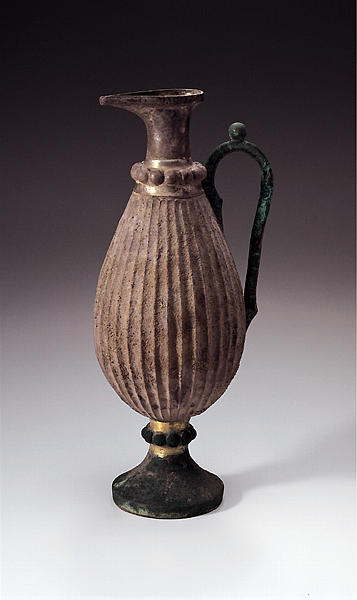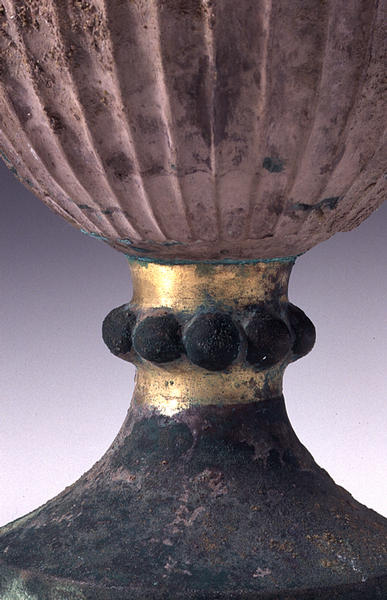水差
- イラン
- ササン朝ペルシア
- 6-7世紀
- 銀鍍金
- H-35.7 D-13
この作品では、胴体と頸部、胴体と台を接合するのに連珠文の装飾を施し、その上下の部分を帯状に鍍金している。西洋梨のような形の本体は縦畝文で装飾している。湾曲した把手の両端は鴨の頭で装飾され、本体に接合している。その上部には玉がつけられている。制作された時は蓋もあったと思われる。ギリシア・ローマ文化とイラン文化はシリアや黒海の北岸や東岸で交流を重ねていた。イランとローマ後期ないしビザンティンの美術様式の折衷・融合がササン朝美術で行われた。この装飾はアケメネス朝ペルシャやギリシャでも行われたことからササン朝の銀細工師はこの長年にわたる伝統を継承した事が分かる。
Catalogue Entry
Marking the junctions of the neck and body and of the body and foot of this silver ewer are beaded bands with gilding on the background. The pear-shaped body has vertical fluting, and the cylindrical neck and foot are plain. The curving handle has duck-headed terminations where it is attached to the body, and a ball at its highest point, which rises almost to the level of the teardrop-shaped spout. Originally, the vessel may have had a lid.
Graeco-Roman and Iranian culture had long shared a common frontier in Syria and on the northern and eastern shores of the Black Sea. A mixture of stylistic elements, Iranian and Late Roman or Byzantine, occurred in the arts of the Sasanian era (A.D. 224-651). The general shape of this ewer is Late Roman in origin.1 Vertical fluting is found on precious metal vessels from the Achaemenid Empire and Greece between the sixth and fourth centuries B.C., and continues during the Seleucid/Parthian era (311 B.C.-A.D. 224) in the Near East.2 Sasanian silverwork appears to have assimilated this long-established tradition. In contrast, however, the beaded bands on this ewer may have been derived from beaded ornamentation on Late Roman silver vessels.3
Ewers of this shape were also produced in Central Asia at approximately the same period, and even influenced the shapes of ceramic ewers in Tang China (A.D. 618-907).4 A remarkable silver gilt ewer with figural decoration derived from Graeco-Roman sources was recently discovered in a Chinese tomb dated to the sixth century A.D.5
Sasanian silver ewers may display animal or vegetal decoration (see cat. no. 53) or diaphanously clothed female figures who hold auspicious objects while walking or dancing. Whether they bear any relationship to the Zoroastrian goddess Anahita (Nahid) is open to question; but as noted in the entry for catalogue number 53, this goddess is depicted on a relief on the back wall of the large rock-cut niche (iwan) at Taq-i Bostan holding the representation of a ewer decorated with a linear pattern representing wavy vertical fluting. This motif has been compared with the pattern on a Sasanian silver-gilt ewer with vertical fluting in the Arthur M. Sackler Gallery in Washington D.C.6 The Sackler vessel is almost identical to the Shumei one, so much so that the two might have been a pair.
Since Roman ewers of this type date from around A.D. 400 onward, the present ewer is very likely late Sasanian in date, and thus of a type that directly influenced the design of early Islamic bronze fluted ewers.7
HI
1. Strong 1966, pp. 188-90; Kent and Painter 1977, p. 54, no. 104.
2. Ghirshman 1964, p. 254, fig. 307; Schmandt-Besserat 1978, p. 76, no. 90, p. 78, no. 94; Bothmer 1984, p. 34, no. 42, p. 38, no. 50, p. 47, no. 77. See also the horizontally fluted beaker of a Shumei Achaemenid rhyton, cat. no. 35, and a similar rhyton with a horse protome from Armenia with vertical fluting in Cultural Contacts 1985, no. 6. For a Hellenistic version of the same type of vessel with vertical fluting see Lukonin 1967, pl. 1.
3. Kent and Painter 1977, pp. 22-23, no. 8, pp. 33-34, nos. 54, 55, 56, etc.
4. Rawson 1992, pp. 144-50, figs. 6-7.
5. Ibid., fig. 6; Wu 1989, pp. 61-70; Carpino and James 1989, pp. 71-5.
6. Gunter and Jett 1992, pp. 202-4, no. 37.
7. Ibid., n.3. See Seven Thousand Years of Iranian Art 1964, p. 33, no. 529, illus. p. 157.

